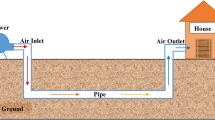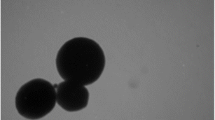Abstract
The present work discusses the design and selection of a shell and tube condenser used in Low Temperature Thermal Desalination (LTTD). To optimize the key geometrical and process parameters of the condenser with multiple parameters and levels, a design of an experiment approach using Taguchi method was chosen. An orthogonal array (OA) of 25 designs was selected for this study. The condenser was designed, analysed using HTRI software and the heat transfer area with respective tube side pressure drop were computed using the same, as these two objective functions determine the capital and running cost of the condenser. There was a complex trade off between the heat transfer area and pressure drop in the analysis, however second law analysis was worked out for determining the optimal heat transfer area vs pressure drop for condensing the required heat load.







Similar content being viewed by others
Abbreviations
- A:
-
Net cross flow / heat transfer area (m2)
- Cp :
-
Specific heat (J/kgK)
- Cgs :
-
HTRI Shell side flow regime parameter
- d:
-
Diameter of tube
- F:
-
Cross flow correction factor
- f:
-
Friction factor
- fis :
-
Isothermal friction factor
- F fb :
-
B stream flow fraction (≅0.6)
- F mr :
-
Momentum recovery factor
- G:
-
Total mass flux (kg/m2s)
- g:
-
Acceleration due to gravity (m/s2)
- h:
-
Heat transfer coefficient (W/m2K)
- K:
-
Thermal conductivity of wall (W/mK)
- L:
-
Tube Length (m)
- m :
-
Total mass flow rate (kg/s)
- Nt :
-
Number of tubes
- Pr:
-
Prandtl number
- p t :
-
Tube pitch (m)
- R:
-
Heat capacity ratio
- R f :
-
Fouling resistance (m2K/W)
- R lh :
-
Homogenous liquid volume fraction
- Re:
-
Reynolds number
- S. gen :
-
Entropy generated
- S:
-
Thermal effectiveness
- T:
-
Temperature of Fluid (K)
- U:
-
Overall heat transfer coefficient (W/m2K)
- y:
-
Weight of vapour fraction
- Δp:
-
Pressure drop (kPa)
- ΔT:
-
Temperature difference (K)
- Δpmr :
-
Two phase momentum pressure drop (kPa)
- ρ:
-
Density (kg/m3)
- μ:
-
Homogenous dynamic Viscosity (Ns/m2)
- φ:
-
Temperature profile function
- ∅v 2 :
-
Ratio of two phase to vapor phase frictional pressure drop
- α:
-
Momentum diffusivity (m2/s)
- ∅h :
-
Physical property correction factor, heat transfer
- ∅p :
-
Physical property correction factor, pressure drop
- c:
-
Cold fluid
- h:
-
Hot fluid
- s:
-
Shell side
- t:
-
Tube side
- sp:
-
Single phase
- w:
-
Wall temperature
- i:
-
In
- o:
-
Out
- l:
-
Liquid
- v:
-
Vapour
- tp:
-
Two phase
- fric:
-
Friction component
- m:
-
Momentum component
References
Thullukanam K (2013) Heat exchanger design handbook, 2nd edn. Taylor & Francis, Boca Raton
Lord RC, Minton PE, Slusser RP (1970) Design of heat exchangers/chemical engineering. McGraw-Hill, New York
Venkatesan G, Iniyan S, Jalihal P (2015) A desalination method utilising low-grade waste heat energy. Desalin Water Treat 56:2037–2045
Venkatesan G, Iniyan S, Goic R (2013) A prototype flash cooling desalination system using cooling water. Int J Energy Res 37:1132–1140
Khalifeh Soltan B, Saffar-Avval M, Damangir E (2004) Minimizing capital and operating costs of shell and tube condensers using optimum baffle spacing. Appl Therm Eng 24:2801–2810
Allen B, Gosselin L (2008) Optimal geometry and flow arrangement for minimizing the cost of shell-and-tube condensers. Int J Energy Res 32:958–969
Yang J, Fan A, Liu W, Jacobi AM (2014) Optimization of shell-and-tube heat exchangers conforming to TEMA standards with designs motivated by constructal theory. Energy Convers Manag 78:468–476
Fettaka S, Thibault J, Gupta Y (2013) Design of shell-and-tube heat exchangers using multiobjective optimization. Int J Heat Mass Transf 60:343–354
Selbas R, Kizilkan O, Reppich M (2006) A new design approach for shell and tube heat exchangers using genetic algorithms from economic point of view. Chem Eng Process 45:268–275
Babu BV, Munawar SA (2007) Differential evolution strategies for optimal design of shell-and-tube heat exchanger. Chem Eng Sci 14:3720–3739
Caputo AC, Pelagagge PM, Salini P (2008) Heat exchanger design based on economic optimization. Appl Therm Eng 28:1151–1159
Sanaye S, Hajabdollahi H (2010) Multi-objective optimization of shell and tube heat exchangers. Appl Therm Eng 30:1937–1945
Patel VK, Rao RV (2010) Design optimization of shell-and-tube heat exchanger using particle swarm optimization technique. Appl Therm Eng 30:1417–1425
Costa ALH, Queiroz EM (2008) Design optimization of shell-and-tube heat exchangers. Appl Therm Eng 28:1798–1805
Eryener D (2006) Thermoeconomic optimization of baffle spacing for shell and tube heat exchangers. Energy Convers Manag 47:1478–1489
TEMA (2007) Standards of tubular exchanger manufacturers association, 9th edn. Tubular Exchanger Manufacturers Association, Tarrytown
Lin JL, Wang KS, Yan BH, Tarng YS (2000) Optimization of electrical discharge machining process based on the Taguchi method with fuzzy logics. J Mater Process Technol 102:48–55
Kang J, Hadfield M (2001) Parameter optimization by Taguchi methods for finishing advanced ceramic balls using a novel eccentric lapping machine. Proc Inst Mech Eng 215:69–78
Phadke MS (1989) Quality engineering using robust design. Prentice Hall, Englewood Cliffs
Ross PJ (1996) Taguchi techniques for quality engineering. McGraw Hill, New York
Shaji S, Radhakrishnan V (2003) Analysis of process parameters in surface grinding with graphite as lubricant based on the Taguchi method. J Mater Process Technol 141:51–59
Paciska T, Jegla Z, Kilkovsky B, Reppich M, Turek V (2013) Thermal analysis of unconventional process condenser using conventional software. Chem Eng Trans 35:469–474
Bhatt D, Priyanka MJ (2014) Shell and tube heat exchanger performance analysis. Int J Sci Res 3(9):2319–7064
Cengel YA (2002) Heat transfer: a practical approach. McGraw-Hill, New York
Shah RK, Sekulic DP (2003) Fundamentals of heat exchanger design. Wiley, New York
Kern DQ (1950) Process heat transfer. McGraw-Hill, New-York
Kandlikar SG (1999) Handbook of phase change: boiling and condensation. Taylor and Fransis, Routledge
Bell KJ, Ghaly MA (1973) An approximate generalised design method for multicomponent/partial condenser. Am Inst Chem Eng J Symp Ser 69:72–79
Silver L (1947) Gas cooling with aqueous condensation. Trans Inst Chem Eng 25:30–42
Yang ZH (2004) Shellside crossflow condensation for pure components with non condensable gases. CS-12 Heat transfer Research Inc, College Station
Baker O (1994) Simultaneous flow of oil and gas. Oil Gas J 53:185–195
Bell KJ, Taborek J, Fenoglio F (1970) Interpretation of horizontal in-tube condensation heat transfer correlations with a two-phase flow regime map. Chem Eng Prog Symp Ser 66:150–163
Mandhane JM, Gregory GA, Aziz K (1974) A flow pattern map for gas-liquid flow in horizontal pipes. Int J Multiphase Flow 1:537–553
HTRI Xchanger Suite Design manual. Heat Transfer Research Inc., Texas
Yang ZH (2000) Reflux condensation in vertical tubes. CT-13 Heat transfer Research Inc, College Station
Bell KJ (1988) Two-phase flow regime considerations in condenser and vaporizer design. Int Comm Heat Mass Transfer 15:429–448
Fernandez-Seara J, Uhia FJ, Sieres J, Campo A (2007) A general review of the Wilson plot method and its modifications to determine convection coefficients in heat exchange devices. Appl Therm Eng 27:2745
Ramires MLV, de Castro Nleto CA, Nagasaka Y, Nagashima A, Assael MJ, Wakeham WA Standard reference data for thermal conductivity of water. NIST, Gaithersburg
Kakac S, Shah RK, Aung W (1987) Handbook of single phase convective heat transfer. Wiley, New York
Zimparov V (2001) Extended performance evaluation criteria for enhanced heat transfer surfaces: heat transfer through ducts with constant heat flux. Int J Heat Mass Transf 44:169–180
Natalini G, Sciubba E (1999) Minimization of the local rates of entropy production in the design of air-cooled gas turbine blades. J Eng Gas Turbines Power 121:466–475
Vuckovic G, Ilic G, Vukic M, Banic M, Stefanovic G (2012) CFD simulation of entropy generation in pipeline for steam transport in real industrial plant. Proceedings of ECOS-2012 the 25th international conference on efficiency, cost, optimization, simulation and environmental impact on energy systems
Kailasam M (2004) Effect of thermal effluent discharge on benthic fauna off Tuticorin bay, south east coast of India. Indian J Mar Sci 33:194–201
Petrescu S (1994) Comments on the optimal spacing of parallel plates cooled by forced convection. Int J Heat Mass Transf 37:1283
Acknowledgments
This work has been done under the funding of Ministry of Earth Sciences (MoES), Govt. of India.
Author information
Authors and Affiliations
Corresponding author
Additional information
Publisher’s Note
Springer Nature remains neutral with regard to jurisdictional claims in published maps and institutional affiliations.
Rights and permissions
About this article
Cite this article
Chandrakanth, B., Venkatesan G, Prakash Kumar L.S.S et al. Thermal design, rating and second law analysis of shell and tube condensers based on Taguchi optimization for waste heat recovery based thermal desalination plants. Heat Mass Transfer 54, 2885–2897 (2018). https://doi.org/10.1007/s00231-018-2326-2
Received:
Accepted:
Published:
Issue Date:
DOI: https://doi.org/10.1007/s00231-018-2326-2




